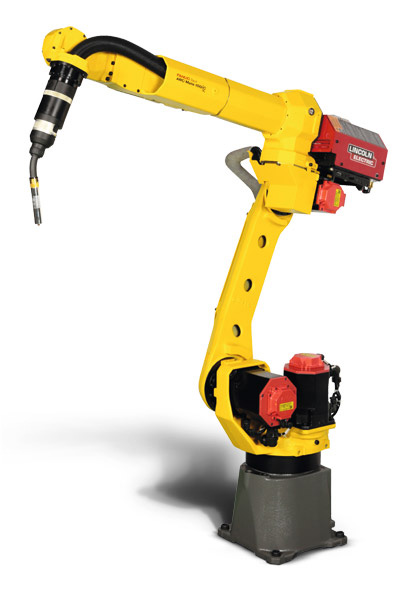Parts of an Industrial Robot
Industrial robots are powerful machines that can be utilized to automate many manufacturing applications. They are comprised of several parts, all of which must work together to allow a robot to function properly and to be able to automate an industrial application. The main parts of a robot include the control system, sensors, arm, end-effector, and motors.
The robotic control system consists of the robot controller and teach pendant. The robot controller is responsible for carrying out application instructions that are inputted through the teach pendant. These instructions serve as the robotic program. In order for the robot to be able to understand coded programs it needs a CPU. A CPU, or Central Processing Unit, is a computer chip that serves as the interpreter for the control system. Programs that are inputted through the teach pendant are analyzed by the CPU in order for the robot to be able to perform the instructions of a given program. In addition to interpreting programs, CPUs also analyze data given as feedback by the robot sensors. This allows the entire control system to best determine how to perform and successfully carryout robotic applications.
Sensors are another important part of industrial robots. They help robots collect data about their surrounding environment in order to accurately and effectively operate. Two of the most common robotic sensors include robotic vision systems and robotic force sensors. Vision systems utilize cameras in order to collect visual data. These types of sensors can significantly improve robot operation or allow for the automation of more complex tasks. For instance, a FANUC M10ia equipped with vision can identify specific parts when mixed among several different types of parts. Robotic force sensors provide sensory feedback in relation to touch. A FANUC M710ic/50 is able to sense when too much pressure is applied to a workpiece during an automated material removal process when equipped with force sensors. Feedback information collected by robot sensors is analyzed by the CPU to make the necessary operational adjustments.
The robot manipulator arm is responsible for moving objects as well as positioning the EOAT towards a workpiece. Robot arms may vary based upon configuration, size, and number of axes, but all serve the same purpose. The most common type of robotic arm is the articulated robot. Examples of articulated robots include the FANUC R2000ib and the ABB 6640. There are also dual arm robots that offer twice the number of degrees of freedom as single arm versions.
Robotic end-effectors are the devices that connect to the robot wrist at the end of the robotic arm. End-effectors are also referred to as robotic end-of-arm-tooling. These devices can be divided into two groups; grippers and tooling. Robotic grippers are generally used for material handling applications, since they can grasp, lift, and maneuver parts. Grippers are highly utilized in robotic assembly and automated pick and place. Tooling end-effectors include welding torches, drills, and paint sprayers among many others. The type of end-effector used will depend upon the robotic application.
Motors, also called actuators, are housed inside an industrial robot. Motors drive the movement of robotic joints. They provide robots the means to function and obtain their programmed positions. Motors for robots may be powered hydraulically, pneumatically, or electronically.




